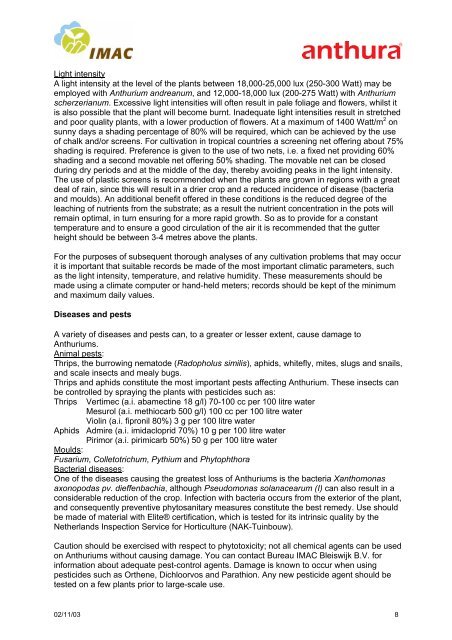Pot Anthurium cultivation guidelines - Sprint Horticulture
Pot Anthurium cultivation guidelines - Sprint Horticulture
Pot Anthurium cultivation guidelines - Sprint Horticulture
Create successful ePaper yourself
Turn your PDF publications into a flip-book with our unique Google optimized e-Paper software.
Light intensity<br />
A light intensity at the level of the plants between 18,000-25,000 lux (250-300 Watt) may be<br />
employed with <strong>Anthurium</strong> andreanum, and 12,000-18,000 lux (200-275 Watt) with <strong>Anthurium</strong><br />
scherzerianum. Excessive light intensities will often result in pale foliage and flowers, whilst it<br />
is also possible that the plant will become burnt. Inadequate light intensities result in stretched<br />
and poor quality plants, with a lower production of flowers. At a maximum of 1400 Watt/m 2 on<br />
sunny days a shading percentage of 80% will be required, which can be achieved by the use<br />
of chalk and/or screens. For <strong>cultivation</strong> in tropical countries a screening net offering about 75%<br />
shading is required. Preference is given to the use of two nets, i.e. a fixed net providing 60%<br />
shading and a second movable net offering 50% shading. The movable net can be closed<br />
during dry periods and at the middle of the day, thereby avoiding peaks in the light intensity.<br />
The use of plastic screens is recommended when the plants are grown in regions with a great<br />
deal of rain, since this will result in a drier crop and a reduced incidence of disease (bacteria<br />
and moulds). An additional benefit offered in these conditions is the reduced degree of the<br />
leaching of nutrients from the substrate; as a result the nutrient concentration in the pots will<br />
remain optimal, in turn ensuring for a more rapid growth. So as to provide for a constant<br />
temperature and to ensure a good circulation of the air it is recommended that the gutter<br />
height should be between 3-4 metres above the plants.<br />
For the purposes of subsequent thorough analyses of any <strong>cultivation</strong> problems that may occur<br />
it is important that suitable records be made of the most important climatic parameters, such<br />
as the light intensity, temperature, and relative humidity. These measurements should be<br />
made using a climate computer or hand-held meters; records should be kept of the minimum<br />
and maximum daily values.<br />
Diseases and pests<br />
A variety of diseases and pests can, to a greater or lesser extent, cause damage to<br />
<strong>Anthurium</strong>s.<br />
Animal pests:<br />
Thrips, the burrowing nematode (Radopholus similis), aphids, whitefly, mites, slugs and snails,<br />
and scale insects and mealy bugs.<br />
Thrips and aphids constitute the most important pests affecting <strong>Anthurium</strong>. These insects can<br />
be controlled by spraying the plants with pesticides such as:<br />
Thrips Vertimec (a.i. abamectine 18 g/l) 70-100 cc per 100 litre water<br />
Mesurol (a.i. methiocarb 500 g/l) 100 cc per 100 litre water<br />
Violin (a.i. fipronil 80%) 3 g per 100 litre water<br />
Aphids Admire (a.i. imidacloprid 70%) 10 g per 100 litre water<br />
Pirimor (a.i. pirimicarb 50%) 50 g per 100 litre water<br />
Moulds:<br />
Fusarium, Colletotrichum, Pythium and Phytophthora<br />
Bacterial diseases:<br />
One of the diseases causing the greatest loss of <strong>Anthurium</strong>s is the bacteria Xanthomonas<br />
axonopodas pv. dieffenbachia, although Pseudomonas solanacearum (I) can also result in a<br />
considerable reduction of the crop. Infection with bacteria occurs from the exterior of the plant,<br />
and consequently preventive phytosanitary measures constitute the best remedy. Use should<br />
be made of material with Elite® certification, which is tested for its intrinsic quality by the<br />
Netherlands Inspection Service for <strong>Horticulture</strong> (NAK-Tuinbouw).<br />
Caution should be exercised with respect to phytotoxicity; not all chemical agents can be used<br />
on <strong>Anthurium</strong>s without causing damage. You can contact Bureau IMAC Bleiswijk B.V. for<br />
information about adequate pest-control agents. Damage is known to occur when using<br />
pesticides such as Orthene, Dichloorvos and Parathion. Any new pesticide agent should be<br />
tested on a few plants prior to large-scale use.<br />
02/11/03 8


